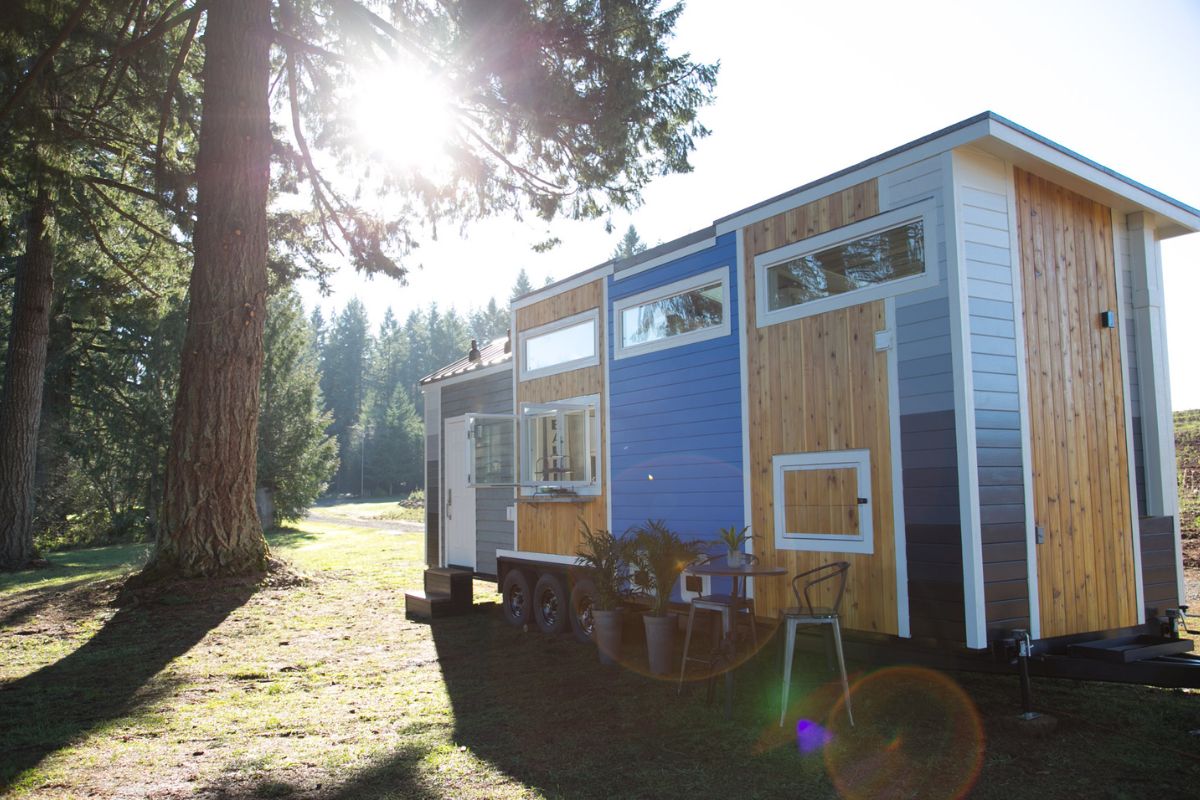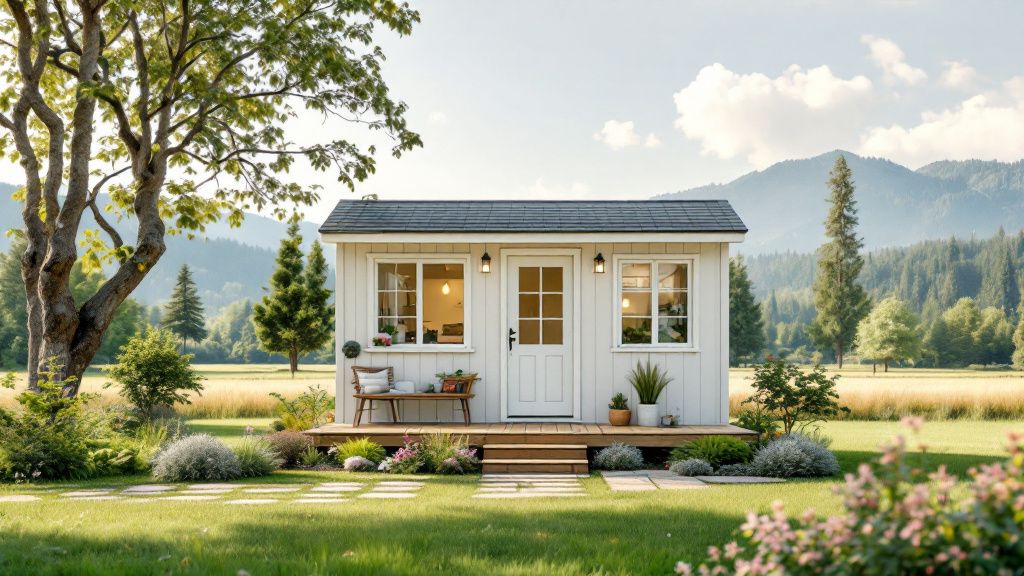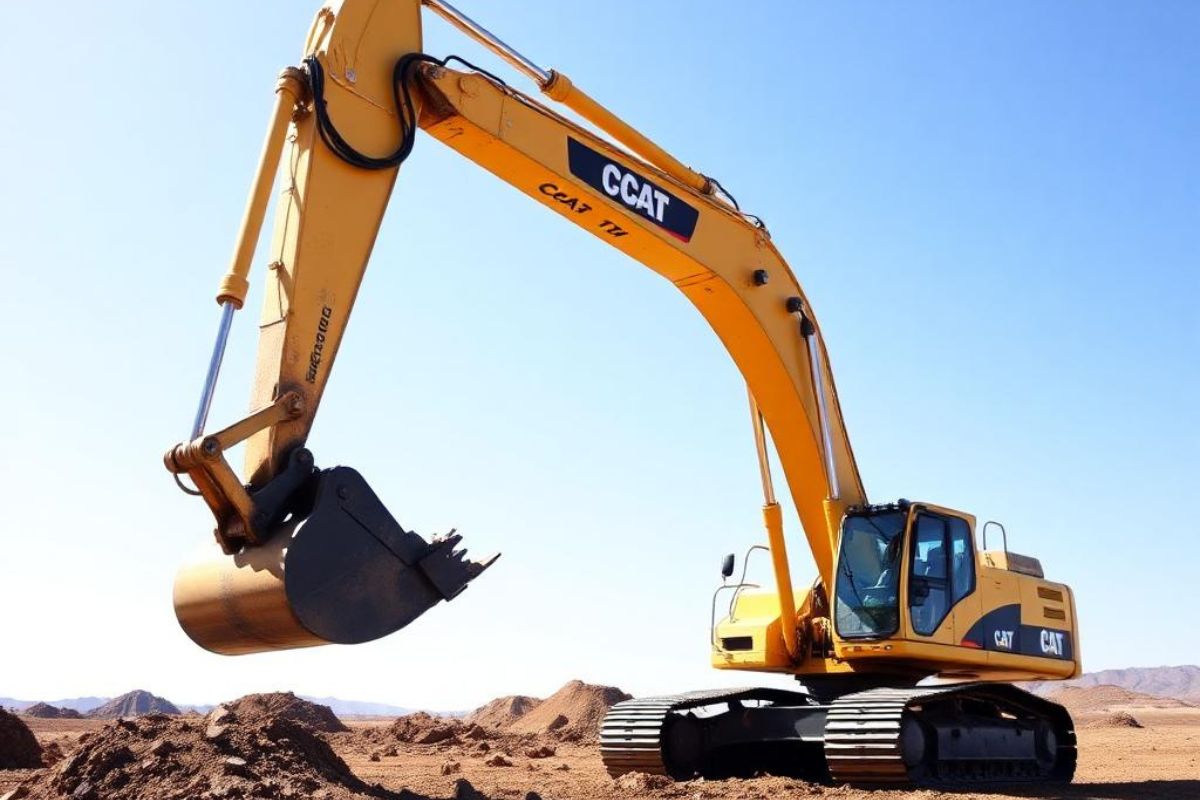Choosing Eco-Friendly Materials
When designing a sustainable tiny house, our choice of materials plays an important role in minimizing environmental impact. We need to prioritize materials that are renewable, recyclable, and non-toxic. Using reclaimed wood, for instance, not only reduces the demand for new lumber but also gives our homes a unique aesthetic. Bamboo is another excellent option due to its rapid growth and durability, making it a renewable resource that's both strong and versatile.
We should also consider insulation materials. Sheep's wool and recycled denim offer excellent thermal properties and are environmentally friendly. These materials help maintain a comfortable indoor temperature, reducing the need for excessive heating or cooling. Choosing natural paints and finishes is vital, as these options contain fewer volatile organic compounds (VOCs), promoting healthier indoor air quality.
Additionally, sourcing materials locally can greatly cut down on transportation emissions. We should look for suppliers who adhere to sustainable practices, ensuring that our materials are ethically produced. By carefully selecting eco-friendly materials, we not only contribute to environmental conservation but also create healthier living spaces. Together, we can make informed choices that reflect our commitment to sustainability in tiny house design.
Energy-Efficient Lighting Solutions
To maximize energy efficiency in our tiny house design, we must focus on lighting solutions that minimize power consumption while maintaining functionality and comfort. LED lights are an excellent choice, offering significant energy savings compared to incandescent bulbs. They consume up to 80% less energy and have a longer lifespan, which reduces replacement frequency and waste. Additionally, LEDs emit less heat, helping to maintain a cooler indoor environment.
We should also consider the strategic placement of lights. Positioning fixtures near reflective surfaces, like white walls or mirrors, can boost brightness without additional energy use. Task lighting, such as under-cabinet LEDs, allows us to concentrate light where needed, reducing the necessity for overhead lighting.

Incorporating smart lighting systems can further improve efficiency. These systems allow us to control lighting remotely and schedule operations, ensuring lights are off when not in use. Dimmers offer another layer of control, enabling us to adjust brightness according to our needs and conserve energy.
Lastly, maximizing natural light by integrating windows and skylights can reduce reliance on artificial lighting. By combining these solutions, we create a well-lit, energy-efficient space without compromising on comfort.
Solar Power Integration
Integrating solar power into tiny house design transforms these compact dwellings into sustainable powerhouses. By utilizing the sun's energy, we reduce reliance on traditional power grids, lower energy costs, and decrease our carbon footprint. The key to effective solar integration lies in understanding energy needs and maximizing space for solar panels.
First, we assess the tiny house's energy requirements. This includes identifying essential appliances and calculating daily energy consumption. With this information, we can determine the right size and type of solar panel system. Photovoltaic panels are typically the go-to choice for their efficiency and long lifespan.
Next, we consider roof space. Tiny houses often have limited roof area, so maximizing efficiency is vital. We might look into high-efficiency solar panels that produce more power per square foot. Additionally, orienting panels towards the sun's path improves energy capture, guaranteeing peak performance.
Energy storage solutions, like lithium-ion batteries, store excess power for cloudy days or nighttime use. Integrating an inverter converts the stored DC power into AC, making it usable for household appliances. By carefully planning solar power integration, we guarantee our tiny homes remain off-grid and sustainable without sacrificing comfort.
Innovative Space-Saving Designs
Having optimized our lighting solutions for energy efficiency, we now turn our attention to innovative space-saving designs that maximize the functionality of tiny homes. The key lies in integrating multipurpose furniture and clever storage solutions. We can blend aesthetics with practicality by using furniture that serves dual functions—like a sofa that transforms into a bed or a dining table that folds into the wall.

Vertical space often remains underutilized, but it's a goldmine for storage. By incorporating shelving that extends to the ceiling, we effectively boost storage capacity without consuming floor area. Additionally, retractable or sliding furniture improves flexibility, allowing us to reconfigure spaces as needed.
In compact kitchens, modular units offer adaptability and efficiency. Countertops can double as dining areas, while pull-out cabinets keep essentials within easy reach. For bathrooms, pocket doors and wall-mounted fixtures save precious inches while maintaining accessibility.
Water Conservation Techniques
Water, a precious resource, requires careful management in tiny house design. With limited space and resources, we need to prioritize efficient water usage. Let's explore a few key techniques.
First, rainwater harvesting is invaluable. By installing a simple collection system on the roof, we can capture and store rainwater for non-potable uses like gardening and toilet flushing. This not only conserves water but also reduces reliance on municipal supplies.
Next, low-flow fixtures play an important role. By opting for low-flow showerheads and faucets, we greatly reduce water usage without sacrificing performance. These fixtures can cut water consumption by up to 50%, making them a smart choice for any sustainable tiny home.
Additionally, greywater recycling systems allow us to reuse water from sinks, showers, and washing machines for tasks like irrigation. By filtering and redirecting this water, we minimize waste and lower overall consumption.
Lastly, composting toilets offer a sustainable alternative to traditional flush systems. They use little to no water, converting waste into compost, and further reducing our environmental footprint.
Incorporating these techniques guarantees that we manage water resources effectively, aligning our living spaces with sustainable practices.
Sustainable Heating and Cooling
While managing water resources effectively is essential, ensuring a comfortable living environment through sustainable heating and cooling is similarly important in tiny house design. Our aim is to minimize energy consumption while maintaining comfort. One way to achieve this is through passive design strategies. By optimizing the house orientation and using high-quality insulation, we can reduce the need for active heating and cooling systems.
Incorporating thermal mass materials, like concrete or brick, helps regulate indoor temperatures by absorbing heat during the day and releasing it at night. Additionally, strategically placed windows and ventilation systems can facilitate natural airflow, reducing reliance on air conditioning.

For active heating, consider installing a small-scale renewable energy system, like a solar thermal collector or a biomass stove. These options provide renewable heat without significant environmental impact. Similarly, energy-efficient heat pumps can serve dual purposes, offering both heating and cooling by transferring heat rather than generating it.
It's vital to choose systems proportionate to our tiny house's size to avoid energy waste. With thoughtful planning and implementation, we can create a sustainable and cozy living space that aligns with our environmental values.
Off-Grid Living Essentials
To truly adopt off-grid living, we must prioritize a self-sufficient infrastructure that supports our daily needs without relying on public utilities. This starts with energy generation. Solar panels are a popular choice due to their decreasing cost and efficiency improvements. Wind turbines can complement solar power, especially in areas with consistent wind. Battery storage systems are essential to store excess energy for use during low production periods.
Water is another critical component. Rainwater harvesting systems can provide a reliable supply, especially when combined with purification systems to guarantee potable water. Greywater recycling also helps maximize water efficiency, allowing us to reuse water from sinks and showers for irrigation.
Waste management is similarly important. Composting toilets offer a sustainable way to handle human waste without water reliance. For solid waste, consider establishing a composting system for organic waste and recycling solutions for other materials.
Lastly, connectivity can be maintained with satellite internet or mobile hotspots, allowing us to stay connected while living sustainably. By thoughtfully integrating these elements, we create a tiny house that not only supports off-grid living but also minimizes our environmental footprint, aligning with sustainable living principles.
Conclusion
In exploring sustainable tiny house design, we've highlighted the importance of eco-friendly materials and energy-efficient lighting. We've shown how innovative space-saving designs can transform limited areas into functional living spaces. Solar power and water conservation techniques improve self-sufficiency, while sustainable heating and cooling guarantee comfort. By integrating these elements, we can adopt off-grid living without compromising modern conveniences. Let's commit to these practices, reducing our environmental footprint and paving the way for a sustainable future.






Share: